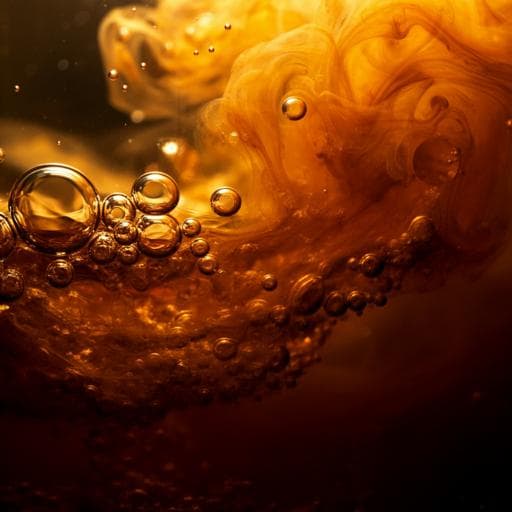
Food Science and Technology
Understanding the lost functionality of ethanol in non-alcoholic beer using sensory evaluation, aroma release and molecular hydrodynamics
I. Ramsey, V. Dinu, et al.
Explore how ethanol levels in beer can transform your tasting experience! This fascinating research by Imogen Ramsey and colleagues reveals that ethanol influences aroma and flavor perception, opening the door to better beer formulations.
~3 min • Beginner • English
Introduction
The study addresses why non-alcoholic beers (NABs) often exhibit altered flavour perception compared to standard beers, focusing on the lost functional role of ethanol in flavour release and sensory perception during consumption. With rising demand for NABs and evidence that ethanol affects headspace partitioning of volatiles and sensory attributes, the research aims to determine how ethanol influences orthonasal and retronasal perception, aroma release in real beer matrices (lager and stout), and interactions with saliva constituents during oral processing. The purpose is to elucidate mechanistic underpinnings—particularly ethanol–saliva interactions—so that insights can inform reformulation strategies to improve the sensory quality and consumer acceptance of 0% ABV beers.
Literature Review
Prior work using trained panels found ethanol increased warming mouthfeel, sweetness and complexity but did not always separate aroma and flavour attributes across 0–4.5% ABV beers (Clark et al.). Missbach et al. reported malty attributes as most pronounced in alcohol-free beer post-swallow. Increasing ethanol from 0 to 5% has been shown to increase retention of aldehydes like 2- and 3-methylbutanal, contributing to 'worty' off-flavours (Perpete & Collin). Static headspace studies (SPME-GC-MS and MS-based methods) generally show increasing ethanol decreases headspace concentrations by increasing solubility of aroma compounds and altering matrix polarity (Aznar et al.; Conner et al.; Escalona et al.; Tsachaki et al.). However, static methods do not capture dynamic oral processing variables like air flow, saliva mixing, mastication, and temperature. Saliva significantly affects retronasal release via interactions with aroma molecules; α-amylase, mucins, and PRPs dominate salivary protein content and can bind aroma compounds, particularly hydrophobics, altering release (Ployon et al.; Pagès-Hélary et al.; van Ruth et al.). Most beer-related research used simple ethanol–water systems; few examined model beer matrices, and no prior work investigated dynamic flavour interactions in real NAB matrices during oral processing. Additional literature indicates matrix macromolecules (proteins, polysaccharides) suppress headspace release and affect sensory perception via diffusion and partitioning effects, and that ethanol can modulate protein structure (alcohol denaturation) affecting binding capacities.
Methodology
Study design integrated consumer sensory testing, in vitro aroma release by SPME-GC-MS, and biophysical hydrodynamic analyses of α-amylase across 0% and 5% ABV conditions in two beer styles (lager, stout). Sensory: 101 beer-consuming adults (53 men, 48 women; age 19–70, mean 32) participated with ethical approval (University of Nottingham G10022017). Base beer for sensory was a commercial 0% ABV lager (Carlsberg). Two treatments were prepared per bottle: (a) 0% ABV: add 30 mL water; (b) 5% ABV: add 18.09 mL 96% ethanol + 11.91 mL water to 300 mL beer to achieve 5% ABV; bottles inverted to mix. Samples (30 mL) were served monadically in randomized Williams Latin Square order with 2 min breaks and water rinses. Orthonasal assessment used CATA with six predefined attributes; retronasal assessment used TCATA over 60 s for ten attributes (flavour, taste, mouthfeel). Data captured with Compusense; CATA analysis via Cochran’s Q with Bonferroni; TCATA via two-factor ANOVA (sample, panelist) with Tukey’s HSD. Physicochemical GC-MS: 0% ABV lager (Carlsberg) and 0% ABV stout (Big Drop) were used as bases; matched 0% and 5% ABV variants were prepared as above. Samples were spiked with a standard flavour mix to ensure detection after dilution, targeting typical beer concentrations: ethyl acetate (8.44 mg/L), isoamyl acetate (0.40 mg/L), ethyl hexanoate (0.41 mg/L), isoamyl alcohol (40.78 mg/L), phenylethyl alcohol (9.96 mg/L), hexanal (0.81 mg/L), furfural (5.99 mg/L), 3-methylbutanal (4.07 mg/L), linalool (0.92 mg/L). α-Amylase from Bacillus licheniformis (10 mg/mL) in 0.1 M phosphate saline was prepared to mimic salivary enzyme and electrolyte levels. For headspace analysis, 2 mL beer + 2 mL buffer or α-amylase were incubated at 40 °C; SPME (DVB/Carboxen/PDMS 50/30 μm) extraction for 10 min; desorption 1 min; GC on ZB-Wax (30 m×0.25 mm) with oven 40–240 °C (8 °C/min) and MS scan m/z 35–200. One-way ANOVA with Tukey’s post hoc assessed ethanol or α-amylase effects (n=4), two-way ANOVA assessed ethanol×saliva×beer style interactions; percentage changes computed relative to controls (0% for ethanol effect; buffer for saliva effect). Hydrodynamics: α-amylase solutions in ethanol/water mixtures across ethanol concentrations were analyzed by sedimentation velocity AUC (Beckman Optima XL-I, 40,000 rpm, 20 °C) to obtain s20,w distributions (SEDFIT), and by Ostwald viscometry at 20 °C to determine intrinsic viscosity [η] (Solomon–Ciuta). Scheraga–Mandelkern relationship used to compute the shape function β and infer gross conformation (axial ratios) via ELLIPS, interpreting changes as ethanol-induced denaturation/conformational elongation. Statistical analyses included ANOVA with Tukey’s HSD and correlation mapping (Pearson) for volatile-behaviour relationships.
Key Findings
- Sensory perception: Orthonasal CATA showed no significant differences between 0% and 5% lager for most attributes; fruity reached p=0.042 but did not separate in post-hoc groupings. Retronasal TCATA revealed significant differences (p<0.05): 0% lager was more malty and less fruity, less sweet, and had lower body and alcohol warming sensation (p=0.000 for body and alcohol warmth), with no significant changes in hoppy, bitter, or sour attributes.
- Static headspace aroma release (SPME-GC-MS): Ethanol (5% ABV) significantly decreased headspace intensities relative to 0% across most compounds in both styles (p<0.05), consistent with increased solubility and reduced partitioning to headspace. Exceptions: furfural in lager and phenylethyl alcohol in stout were not significantly reduced (per supplementary data).
- Matrix effects: Stout exhibited lower headspace concentrations than lager for most compounds at matched ethanol levels, attributed to higher carbohydrate and protein content in stout (6.7 g/100 mL carbohydrates; 0.6 g/100 mL protein) versus lager (5.6 g/100 mL carbohydrates; 0.3 g/100 mL protein), implying macromolecular suppression/diffusion limitations.
- α-Amylase effects: Addition of α-amylase decreased headspace release overall, with stronger effects for hydrophobic compounds (higher logP). Significant effects observed for ethyl acetate, 3-methylbutanal, isoamyl alcohol, hexanal, isoamyl acetate in lager; and for furfural, ethyl acetate, 3-methylbutanal, isoamyl alcohol, isoamyl acetate in stout (p<0.05). Radar/logP analyses showed that in the presence of α-amylase, 5% beers had a higher relative proportion of hydrophobic compounds in headspace versus 0% beers, while 0% beers exhibited relatively higher hydrophilic compounds (e.g., worty/malty notes).
- Ethanol–saliva synergy: Ethanol subtly inhibited binding of hydrophobic volatiles to α-amylase, increasing their headspace concentration at 5% versus 0% ABV in mixed systems, aligning with sensory shifts toward fruitier/estery profiles in 5% beers.
- Hydrodynamics of α-amylase: Increasing ethanol concentration led to decreased sedimentation coefficient s20,w and increased intrinsic viscosity [η], indicative of conformational change from compact (globular) toward elongated forms (higher axial ratios) due to ethanol-induced denaturation. This implies fewer hydrophobic pockets in partially unfolded α-amylase, reducing entrapment of hydrophobic aroma molecules and contributing to greater release of hydrophobics at 5% ABV.
Overall, the combined data link ethanol presence to dynamic ethanol–saliva interactions that modulate flavour release and retronasal perception, explaining maltier, less fruity/sweet, and lower body/warmth profiles in 0% beer relative to 5% beer.
Discussion
Findings demonstrate that ethanol per se exerts minimal impact on orthonasal detection in lager but substantially alters retronasal perception during consumption via interactions occurring in the bolus. Ethanol reduces static headspace of most volatiles, yet in the presence of saliva components—modeled here by α-amylase—ethanol induces protein conformational changes that lessen hydrophobic binding capacity, allowing more hydrophobic aromas (e.g., linalool, ethyl hexanoate, isoamyl acetate) to remain in the headspace during consumption. Consequently, 5% ABV beers skew towards fruitier/estery profiles and greater sweetness, body, and alcohol warming, while 0% beers emphasize more hydrophilic, malty/worty notes (e.g., furfural, 3-methylbutanal). Matrix composition modulates release further, with macromolecule-rich stout suppressing headspace more than lager. The hydrodynamic evidence provides a mechanistic basis: ethanol partially denatures α-amylase (increasing [η], decreasing s20,w), reducing hydrophobic pocket availability and thus decreasing sequestration of hydrophobic volatiles. These mechanisms reconcile discrepancies between static headspace measurements and in-mouth sensory outcomes and highlight the central role of ethanol–saliva–matrix interactions in shaping beer flavour perception.
Conclusion
This integrated sensory–analytical–biophysical study shows that ethanol’s lost functionality in NABs arises largely from ethanol–saliva interactions during oral processing. While 5% ethanol reduces static headspace intensities, in the presence of salivary α-amylase ethanol induces conformational changes that diminish hydrophobic binding, increasing the relative release of hydrophobic, fruity/estery compounds and contributing to sweetness, body, and warming sensations. Conversely, 0% ABV beers present a sensory shift toward hydrophilic, malty/worty notes. These effects occur in both lager and stout matrices, with matrix macromolecules further suppressing volatile release. The work suggests reformulation strategies for 0% ABV beers, including designing matrix components (e.g., dextrins, glycerol) to mimic ethanol’s functional roles or leveraging oral mucoadhesives to modulate aroma–saliva interactions. Future research should extend mechanistic studies to other salivary components (mucins, PRPs, α-amylase glycoforms) and explore broader beer matrices and dynamic in vivo measurements to optimize flavour delivery in NABs.
Limitations
- Salivary system was modeled primarily with α-amylase in buffer rather than whole saliva; contributions from mucins, PRPs, and enzyme glycoforms were not directly tested.
- In vitro aroma measurements employed static headspace SPME-GC-MS; although informative, they do not fully replicate dynamic in-mouth conditions (airflow, temperature gradients, mastication).
- Volatile compounds were spiked to ensure detection after dilution, which may not perfectly reflect native concentrations or interactions across diverse commercial beers.
- Only two beer styles (lager and stout) and two ethanol levels (0% and 5% ABV) were examined, potentially limiting generalizability across beer categories and alcohol ranges.
- Sensory orthonasal testing used a limited attribute set and a single lager base; broader panels and styles might reveal additional differences.
Related Publications
Explore these studies to deepen your understanding of the subject.







